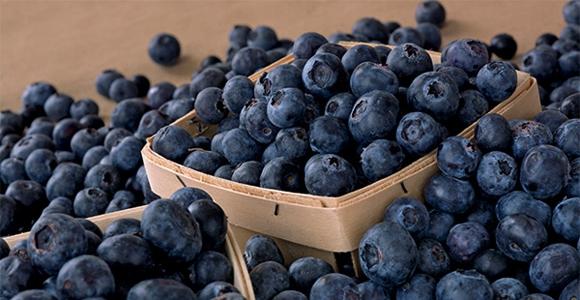Blueberries are the most widely grown fruit crop in the United States. Blueberries are well-suited to organic culture, and good markets exist for organically grown blueberries. The production guide, Blueberries: Organic Production by the Natonal Sustainable Agriculture Information Service, addresses key aspects of organic blueberry production, including soils and fertility, cultural considerations, pests, and diseases, as well as marketing. Additional resources are provided for further investigation.
This publication focuses on organic blueberry production, specifically the highbush and rabbiteye species, and is most relevant to production conditions east of the Rocky Mountains. It does not go deeply into many of the basics of blueberry culture—variety choice, planting, pruning and training—which are largely the same under both organic and conventional management. Such general information is available from your state’s Cooperative Extension Service and many horticulture books, periodicals, and bulletins. Nor does this publication address organic production of lowbush blueberries. The Maine Organic Farmers and Gardeners Association (MOFGA) and K-Ag Laboratories International in Wisconsin both have information on organic culture of native, unimproved lowbush blueberries.
Information in the publication includes:
Choosing a Variety
Blueberries are members of the genus Vaccinium and belong to the Rhododendron family (Ericaceae). The Vaccinium genus contains several species of economic importance. The highbush blueberry (Vaccinium corymbosum) is the most widely cultivated, grown from the Mid-Atlantic to California, Oregon, and Washington, and from the Upper Midwest to the Mid-South. The lowbush (wild) blueberry (V. angustifolium) is adapted to the far North and is commercially important in Maine, Eastern Canada, and parts of New Hampshire, Massachusetts, Michigan, and Wisconsin. Rabbiteye (V. ashei) is a large bush well-adapted to the South, in the region roughly south of Interstate 40. Southern highbush (V. corymbosum x V. darrowi), a new hybrid, is adapted to the southern rabbiteye zone as well as the coastal South. It has a lower chilling-hours requirement, and it flowers and fruits earlier than highbush or rabbiteye varieties.
Soils and Fertility
The Importance of Soil pH
Blueberries are distinct among fruit crops in their soil and fertility requirements. As members of the Rhododendron family, blueberries require an acidic (low pH) soil, preferably in the 4.8 to 5.5 pH range. When soil pH is appreciably higher than 5.5, iron chlorosis often results; when soil pH drops below 4.8, the possibility of manganese toxicity arises. In either case, plants do not perform well.
Blueberry Fertilization Practices
Soil-building practices prior to establishment can go a long way toward providing the fertility necessary for a healthy blueberry planting. High levels of soil organic matter are especially important in blueberry culture, contributing to the soil’s ability to retain and supply moisture to the crop, buffering pH, and releasing nutrients through decay. Soils rich in organic matter are also a desirable environment for symbiotic mycorrhizal fungi that assist blueberry roots in absorbing water, nitrogen, phosphorus, and other minerals.(Yang et al., 2002) Green manures in advance of planting can play an important part in cycling organic matter into the soil system, as can applications of composts and livestock manures. ATTRA has several publications that can be useful in these areas, including Overview of Cover Crops and Green Manures, Manures for Organic Crop Production, and Farm-Scale Composting Resource List.
Cultural Considerations
Plant Spacing
Highbush blueberries are typically spaced 4 to 4½ feet in the row, with 8 to 12 feet between rows. As bushes can get quite large at maturity, many growers find that 10– to 12–foot row spacings—approximately 900 to 1090 plants per acre—are preferable for tractor operations (mowing, harvesting, and spraying). Rabbiteyes are typically spaced at 5 to 8 feet within a row, with 12 to 14 feet between the rows, or 388 to 726 plants per acre.
Inter-row Management
Blueberries do not have extensive root systems. As a result, clean cultivation of row middles to control weeds and to incorporate cover crops is less damaging to blueberries than it is to bramble fruits. Still, it is wise to till no deeper than 3 inches. Similarly, inter-row living mulches—also called sodded middles—generally are not competitive with the crop unless the inter-row species are aggressive and invade the rows. Fescue is commonly used in the Mid-South for sodded middles, as are several other grass species.
In-row Weed Management and Mulching
Weeds are considered by many growers to be the number one problem in organic blueberry culture. It is especially important to control aggressive perennial weeds such as johnsongrass, bermudagrass, and quackgrass prior to crop establishment. Sites with these grasses should generally be avoided for blueberry establishment. Details of pre-plant and post-plant weed management for all fruit plants are provided in ATTRA’s Overview of Organic Fruit Production. Some techniques, however, deserve additional elaboration.
Pollination
Blueberries are insect-pollinated; thus, increasing the number of pollinators can be quite beneficial. Blueberry flowers vary greatly in size and shape, depending on species.(Lyrene, 1994) Therefore, having a variety of pollinators like horn-faced bees, mason bees, carpenter bees, bumblebees, orchard bees, and others is important for good fruit set.
The guide also addresses insect pests, diseases, bird and rodent control and economics.
Reference:
Kuepper, George L. and Steve Diver. Blueberries: Organic Production. 2010. Retrieved 26 August 2010.
Contact:
Krisanna Machtmes, LSU AgCenter
